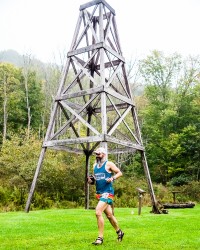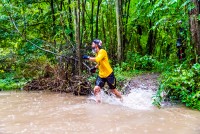I’ve seen the articles. You know the ones I mean. The ones that promise the moon and stars for less effort.
Run less and PR! Run Short, Get Fast! Couch Surf Your Way to 50k! Ok maybe not that last one. As a high mileage runner I always wondered if their were merits to the idea, but sure wasn’t going to risk performance to find out. That was until this past year. A funny thing happened. I was working long hours through much of the summer; 13-15 hours a day for some stretches and I just didn’t want to get up early to get my run in before that. I still loved running, but I didn’t love it enough to kill myself over it. In 2016, while training for my first 100 miler I was getting up at 2-3 AM to get those 20-30 mile training runs in and still meet the demands of work and home. I was used to 5 hours a night of sleep, sometimes less. This year I just don’t have it in me to do that. I’ve been running 10-25 miles per week over 1-2 runs. It’s the ALL THE MILES ALL AT ONCE plan.
As the trail runs got longer I began to notice I was feeling good at distance despite not really putting that work in of 4-5 runs per week. So the answer to the big question began to gain traction in my mind with an affirmative response. Is it possible to run a bare minimal training plan and succeed at big distance? I plan to find that out in 2018.
Now it’s not so simple as run once a week and kill all your races. There is something else I am doing aside from running. That something is making a big difference in how I feel on long runs and on big hill climbs…..ready for it? You know the answer as well as I do. Say it with me kids! CROSSTRAINING! Once to twice a week I’m hitting the gym. One of those days typically involves beating to crap out of my legs. The other day more of a full body workout with focus on arms, abs, and shoulders.
Legs for days
My new favorite instrument of torture is the sled. It’s metal thingamabob that I put weights on and push back and forth over astroturf. A sprint down the green stuff for 30 yards and follow up with 10 squat jumps (ouch), a slow push back 30 yards followed by 10 more squat jumps (OUCH) , and I repeat this as much as I can take. After a 10-15 minute workout of these and lunges my legs were more trashed than after running a PR marathon! Really! I felt it for days. Some other ways I’ve been putting the hurt on include the arc trainer, weighted lunges, hack press and leg presses. If there are two things every runner needs more of it is hip and glute strength and these routines are delivering which means more endurance and better performance on the hills. A friend of mine, Lisa, always talked about someone she knows that does triathlons and ultras, but never runs over 17 miles in training. I’m not ready to forsake my long runs, nor do I want to go that minimal…I love running, but my ears are open.
Nutrition
Fueling right during the run and on a daily basis will improve performance greatly. It’s a no brainer, right? The hard part is finding what works for you. What works for me might not be the best approach for you, but there are some basic things that I feel confident in suggesting.
Raw foods – Loads of raw, fresh, organic vegetables. I like to pile as much as I can into one bowl and have that as my main course for dinner. Throw an egg on for protein and an avocado for healthy fats , top with the only acceptable salad dressing, vinaigrette, and consume frequently.
A typical salad for me has:
spinach, arugula, parsley, carrots, tomatoes, sharp cheddar cheese, cucumber, olives, chia seeds, avocado, and when available edible flowers add a nice touch with high nutrient load and low caloric density.
This type of eats packs way more goodies than any multi-vitamin will ever supply.
Sugars – Reduce, or better yet, eliminate refined sugars from your diet all together. The first couple of weeks are tough, but you’ll come out on the other side feeling better with more energy. Sugar does absolutely zero good for your body’s operation and even less good for your post-workout recovery. Reduce it. That goes for GUs and bloks and all these other “running fuels” that are primarily simple sugars. That isn’t fuel people! It’s candy! Complex carbs are going to provide steadier energy or better still adapting your body to burn fat as a primary fuel source. I use Hammer Heed and gel on shorter efforts, but when it comes to multi-hour events Perpetuem treats me well. It has complex carbs along with small amounts of fat, protein, and amino acids. Plus, in my opinion, it tastes way better.
Carb-loading – I suggest NOT doing this..especially before a race!! We eat a certain way all through training and then 3 days before the big race we change it all up by piling pounds of pastas, bread, baked goods down our gullets in the name of carb-loading. The best time to “carb-load” is within 30 to 60 minutes of completing that workout. This is the time the glycogen synthase enzyme is most active allowing more glycogen to be taken in and increasing the body’s ability to store it. Don’t forget the protein though! A 3:1 ratio of grams of carbohydrate to protein is optimal for rebuilding the damaged muscles after a hard workout and gaining strength. I use Hammer Recoverite after all hard efforts.
Hydration
You can be doing everything right, but if your hydration and electrolyte needs are not met then you will suffer and your times along with it. Electrolyte supplementation is something I take deadly serious. The medication I take for seizures lowers my blood sodium level considerably so the risk of hyponatremia is very real. Hyponatremia is a condition resulting from abnormally low sodium levels in the body. Click the link above for all the nitty gritty info. The important take away is it can make you very ill and even kill you. Nothing quite messes up a good run up like dying. For me, I take 1-2 Hammer Endurolytes Extreme caps per hour…sometimes even as much as 3. Chances are you don’t need this much. One to two standard strength Endurolytes per hour will probably set you right. Low electrolytes are one of the leading causes of cramping.
Now that your electrolyte game is on-point you’ll need to properly wash those salt pills down. Most athletes need 20-25 ounces of water per hour. By the time you feel thirsty it’s already too late. Practice taking a sip every few minutes. Most bottles are around 17-21 ounces so it’s easy to tell if you are drinking enough. Roughly one bottle per hour.
Run Less and Do More
So maybe running less can yield better results in races. So far my experiment of one is looking promising. But simply running less isn’t going to produce those results. There needs to be a balance. Less weekly miles, but more crosstraining. Simply adding a good crosstraining regiment or simply eating healthier or simply dialing in your electrolyte and hydration can all improve your performance. Put them all together though and you’ll amaze yourself and everyone around you.













Leave A Comment